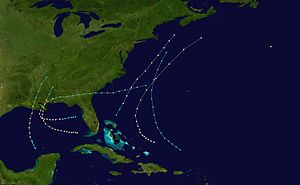1860 Atlantic hurricane season
| 1860 Atlantic hurricane season |

Season summary map
|
| Seasonal boundaries |
| First system formed |
August 8, 1860 |
| Last system dissipated |
October 24, 1860 |
| Strongest storm |
|
| Name |
One |
| • Maximum winds |
130 mph (215 km/h) |
| • Lowest pressure |
950 mbar (hPa; 28.05 inHg) |
| Seasonal statistics |
| Total depressions |
7 |
| Total storms |
7 |
| Hurricanes |
6 |
| Total fatalities |
At least 60 |
| Total damage |
$1.25 million (1860 USD) |
|
|
Atlantic hurricane seasons
1858, 1859, 1860, 1861, 1862
|
| Category 3 hurricane (SSHWS) |
|
|
| Duration |
August 8 – August 16 |
| Peak intensity |
125 mph (205 km/h) (1-min) 950 mbar (hPa) |
| Category 2 hurricane (SSHWS) |
|
|
| Duration |
August 24 – August 26 |
| Peak intensity |
105 mph (165 km/h) (1-min) |
| Category 1 hurricane (SSHWS) |
|
|
| Duration |
September 11 – September 11 |
| Peak intensity |
80 mph (130 km/h) (1-min) |
| Category 2 hurricane (SSHWS) |
|
|
| Duration |
September 11 – September 16 |
| Peak intensity |
105 mph (165 km/h) (1-min) 969 mbar (hPa) |
| Tropical storm (SSHWS) |
|
|
| Duration |
September 18 – September 21 |
| Peak intensity |
70 mph (110 km/h) (1-min) |
| Category 2 hurricane (SSHWS) |
|
|
| Duration |
September 30 – October 3 |
| Peak intensity |
105 mph (165 km/h) (1-min) 969 mbar (hPa) |
| Category 2 hurricane (SSHWS) |
|
|
| Duration |
October 20 – October 24 |
| Peak intensity |
105 mph (165 km/h) (1-min) |
During the 1860 Atlantic hurricane season, three severe hurricanes struck Louisiana and the Gulf Coast of the United States within a period of seven weeks. The season effectively began on August 8 with the formation of a tropical cyclone in the eastern Gulf of Mexico, and produced seven known tropical storms and hurricanes until the dissipation of the last known system on October 24. Six of the seven storms were strong enough to be considered hurricanes on the modern-day Saffir–Simpson Hurricane Scale, of which four attained Category 2 status and one attained Category 3 major hurricane strength. The first hurricane was the strongest in both winds and pressure, with peak winds of 125 miles per hour (201 km/h) and a barometric pressure of 950 millibars (28 inHg). Until contemporary reanalysis discovered four previously unknown tropical cyclones that did not affect land, only three hurricanes were known to have existed; all three made landfall in Louisiana, causing severe damage.
The first two hurricanes to strike the Gulf Coast—in August and September, respectively—caused significant inundation of low-lying and coastal communities, inflicting severe damage and killing dozens of people. In some cases, flood waters were more than 12 ft (3.7 m) deep, and the center of destruction shifted slightly with each storm. Sugar cane crops were destroyed by these two systems as well as the succeeding storm in early October. Property and infrastructure suffered with all three events. With the third storm that made landfall, extreme winds blasted the city of New Orleans and surrounding areas. All other storms remained away from land with no effects except on shipping.
Prior to the advent of modern tropical cyclone tracking technology, notably satellite imagery, many hurricanes that did not affect land directly went unnoticed, and storms that did affect land were not recognized until they made landfall. As a result, information on older hurricane seasons was often incomplete. Modern-day efforts have been made and are still ongoing to reconstruct the tracks of known hurricanes and to identify initially undetected storms. In many cases, the only evidence that a hurricane existed was reports from ships in its path. However, judging by the direction of winds experienced by ships, and their location in relation to the storm, it is possible to roughly pinpoint the storm's center of circulation for a given point in time. This is the manner in which four of the seven known storms in the 1860 season were identified by hurricane expert José Fernández Partagás's reanalysis of hurricane seasons between 1851 and 1910. Partagás also extended the known tracks of three other hurricanes previously identified by scholars. The information Partagás and his colleague uncovered was largely adopted by the National Oceanic and Atmospheric Administration's Atlantic hurricane reanalysis in their updates to the Atlantic hurricane database (HURDAT), with some slight adjustments. HURDAT is the official source for such hurricane data as track and intensity, although due to a sparsity of available records at the time the storms existed, listings on some storms are incomplete.
...
Wikipedia








